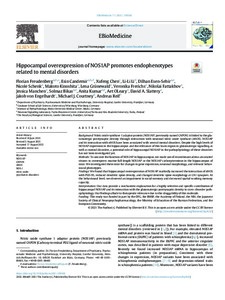Hippocampal overexpression of NOS1AP promotes endophenotypes related to mental disorders
Freudenberg Florian; Candemir Esin; Chen Xufeng; Li Li-Li; Esen-Sehir Dilhan; Schenk Nicole; Kinoshita Makoto; Grünewald Lena; Frerichs Veronika; Fattakhov Nikolai; Manchen Jessica; Bikas Solmaz; Kumar Anita; OLeary Aet; Slattery David A.; von Engelhardt Jakob; Courtney Michael J.; Reif Andreas
Hippocampal overexpression of NOS1AP promotes endophenotypes related to mental disorders
Freudenberg Florian
Candemir Esin
Chen Xufeng
Li Li-Li
Esen-Sehir Dilhan
Schenk Nicole
Kinoshita Makoto
Grünewald Lena
Frerichs Veronika
Fattakhov Nikolai
Manchen Jessica
Bikas Solmaz
Kumar Anita
OLeary Aet
Slattery David A.
von Engelhardt Jakob
Courtney Michael J.
Reif Andreas
Elsevier
Julkaisun pysyvä osoite on:
https://urn.fi/URN:NBN:fi-fe2021093048471
https://urn.fi/URN:NBN:fi-fe2021093048471
Tiivistelmä
BACKGROUND\nMETHODS\nFINDINGS\nINTERPRETATION\nFUNDING\nNitric oxide synthase 1 adaptor protein (NOS1AP; previously named CAPON) is linked to the glutamatergic postsynaptic density through interaction with neuronal nitric oxide synthase (nNOS). NOS1AP and its interaction with nNOS have been associated with several mental disorders. Despite the high levels of NOS1AP expression in the hippocampus and the relevance of this brain region in glutamatergic signalling as well as mental disorders, a potential role of hippocampal NOS1AP in the pathophysiology of these disorders has not been investigated yet.\nTo uncover the function of NOS1AP in hippocampus, we made use of recombinant adeno-associated viruses to overexpress murine full-length NOS1AP or the NOS1AP carboxyterminus in the hippocampus of mice. We investigated these mice for changes in gene expression, neuronal morphology, and relevant behavioural phenotypes.\nWe found that hippocampal overexpression of NOS1AP markedly increased the interaction of nNOS with PSD-95, reduced dendritic spine density, and changed dendritic spine morphology at CA1 synapses. At the behavioural level, we observed an impairment in social memory and decreased spatial working memory capacity.\nOur data provide a mechanistic explanation for a highly selective and specific contribution of hippocampal NOS1AP and its interaction with the glutamatergic postsynaptic density to cross-disorder pathophysiology. Our findings allude to therapeutic relevance due to the druggability of this molecule.\nThis study was funded in part by the DFG, the BMBF, the Academy of Finland, the NIH, the Japanese Society of Clinical Neuropsychopharmacology, the Ministry of Education of the Russian Federation, and the European Community.
Kokoelmat
- Rinnakkaistallenteet [27094]
